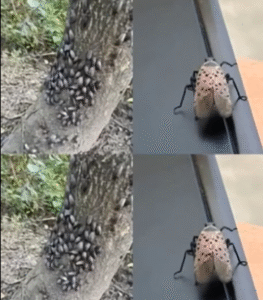See This Insect? Don’t Wait—Take Immediate Action to Protect Your Plants and Trees

An urgent threat is creeping across the U.S.—and if you see this striking insect in your backyard, vineyard, or park, do not ignore it.
The spotted lanternfly (Lycorma delicatula) might look beautiful with its patterned wings and bright red colors, but behind that vivid exterior lies a devastating menace to trees, crops, and entire ecosystems.
A Fast-Spreading Pest Wreaking Havoc
First spotted in Pennsylvania back in 2014, this invasive insect has rapidly made its way through multiple states. Its presence has already caused severe damage to fruit farms, ornamental trees, and vineyards, leaving devastated landscapes and financial losses in its wake.
How They Attack Plants
Lanternflies feed by piercing plant tissue and sucking out sap, draining plants of strength. As they feed, they secrete a sticky residue called honeydew, which attracts sooty mold—a black fungus that blocks sunlight and stunts plant growth.
The result? Trees weakened, crops damaged, and gardens ruined.
What to Look For
Adults:
-
Around 1 inch long
-
Gray wings with black dots
-
Bright red underwings when open
-
Camouflaged when wings are folded
Nymphs (juveniles):
-
Start out black with white spots
-
Later become bright red with black and white markings
Egg masses:
-
Appear as mud-like smears on trees, furniture, rocks, or vehicles

What They Destroy
Lanternflies target a wide range of plant life, including:
-
Hardwood trees like maple and walnut
-
Fruit trees such as grapevines, apples, and pears
-
Cash crops like hops and ornamental plants
Even urban trees and backyard shrubs aren’t safe.
If You See One—ACT FAST
Don’t assume someone else will handle it. Here’s what to do:
-
Squash it.
Yes, seriously. Stomping out adults or nymphs on sight helps limit their spread. -
Destroy the eggs.
Scrape any egg masses into a jar filled with alcohol, hand sanitizer, or bleach. -
Report the sighting.
Contact your state agriculture department or environmental agency. Reporting helps scientists track and fight infestations. -
Inspect before you move.
Before taking furniture, vehicles, or firewood across state lines, check for egg masses. Eggs are often missed and can hatch far from the original infestation.
This Is Bigger Than a Backyard Problem
These pests don’t stop at farms. They stress urban greenery, mess with ecosystems, and pose risks to wildlife and birds. Once they settle in, they’re incredibly hard to eliminate—so prevention and quick action are essential.
One Bug, One Big Difference
Your action matters. If you see a spotted lanternfly, kill it. Report it. Spread the word.
Together, we can help stop this invasive threat before it does even more damage.
Don’t delay—take action today.